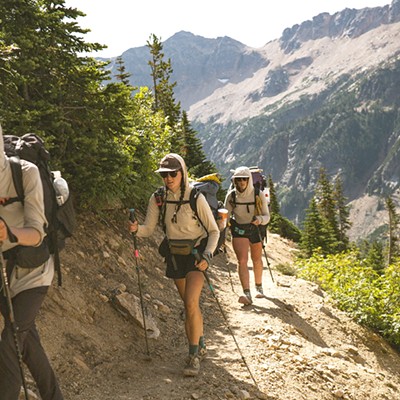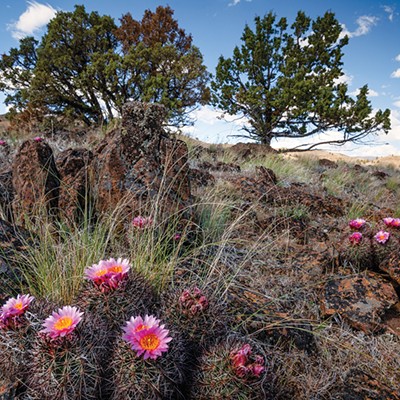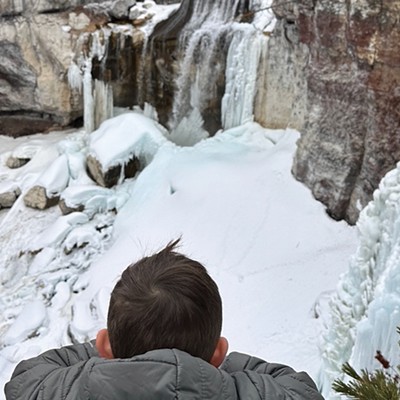Come early August dedicated steelheaders know that what happens on the lower Deschutes stays on the lower Deschutes. And I won’t break that confidence.
However, it’s no secret that the annual steelhead pilgrimage has begun on the Columbia River, which has fish junkies like myself trekking north in hopes of intercepting some of the early arrivals, including the strong push of wild fish that make up a good chunk of the early “run” on the Columbia and tributaries including the lower Deschutes.Early numbers show that the run is slightly off the 10-year average with roughly 108,000 steelhead passing Bonneville Dam the first of three dams on the lower Columbia River, as of Aug. 6. That’s about 40,000 less than last year and about 35,000 less than the 10-year average. However, that data includes the banner 2009 year when nearly 800,000 steelhead returned to the Columbia system, as opposed to annual returns between 400,000 and 500,000.
The good news is that about 46,000 of those fish are wild steelhead, offering some hope of long-term recovery for the species and the sport fishery, which is largely sustained by a costly and long-term detrimental hatchery program.
Consider, that of the 567,000 fish that returned in 2009, only 150,000 were wild, or about 27 percent. That’s compared to pre-dams and developments runs in the million-plus range.
While the bulk of the run will likely arrive in late August or September, when as many as 10,000 fish will swim past Bonneville dam on a daily basis, steelhead are beginning to show up in numbers on the lower Deschutes as far up as Sherars Falls, downriver from Maupin.
“They’re not as high as the Warm Springs section, but a few guys had a lot of success down by the mouth. There is definitely some good steelheading to be had. It’s begun for sure,” said Drew Harrison, of The Fly Fisher’s Place in Sisters, whose guides have been out on the lower river recently.
As with the past two years, high water temperatures are affecting the fishing. The recent heat wave, relatively speaking given what’s happened across the rest of the country, has caused water temperatures to spike in the afternoons. The U.S. Geological Society reported evening temperatures in excess of 70 degrees on Monday afternoon at the Moody Gauge near the Columbia confluence. Those kind of temps can be potentially fatal to fish if an angler hooks them.
When faced with that situation last weekend, our group opted to just hang in the shade and restock the beer cooler rather than risk landing and harming a wild fish.
While the high temps may have killed afternoon and evening fishing, one of the prime times to entice steelhead to a swung fly, it’s not all gloom. The Columbia River temps have recently jumped up to around 69 degrees, making the Deschutes an attractive, if temporary refuge for fish that are headed elsewhere in the system, said Don Ratliff, a biologist for PGE who is overseeing the Upper Basin Reintroduction effort. PGE is one of the stakeholders involved with the new water management scheme at the Pelton-Round Butte dam complex.
Under the new approach, made possible by a multimillion-dollar water withdrawal system, river managers are able to adjust the temperature of the outgoing water at the dam by pulling from different parts of the water column in the reservoir at Lake Billy Chinook. Critics have blamed the system for some of the increased temperatures and difficult fishing over the past two seasons, particularly in late July and August when water temperatures have spiked. Veteran Deschutes Guide Jeff Hickman said he's been pulling off the water around noon in recent days over concerns about fish mortality. But he's seen a fair number of anglers still casting in the mounting heat and a few dead fish to validate his concerns. He blames the new water release schedule for the problems. He'd like to see more cooler water released in the heat, barring that he'd like to see new regulations that cut off fishing in extreme water temps.
Ratliff said he understands the frustration of anglers and guides, but that the criticism is misplaced. While managers are blending water to mimic natural temperatures, i.e. as if the dam complex were not there, the biggest impact on fishing over the past few seasons has been the fact that the Columbia has run cooler than its historical average. As a result, fewer stray fish entered the Deschutes system. Fewer fish equals less catching—math. Ratliff estimates that, despite the temporarily high temperatures, those non-resident fish are again turning their noses up the Deschutes in search of a quick respite.
“I think there are quite a few stray fish up there; I call them wanderers because they're going to go back out and up the Columbia,” Ratliff said.
In the meantime anglers will have ample opportunity to interdict—that is, if you’re willing to wake up at 4 a.m. and beat the sun to the water.
A Different Swing
I recently had a chance to explore Pronghorn’s impressive golf instructional facility, which, for a self-taught golfer who had never had a lesson, was a particular indulgence.
Since the resort was sold earlier this year, Pronghorn’s new owner, Hawaii-based Resort Group, has made some small and not so small changes. One of the latter was to bring in renowned golf instructor Tim Mahoney for a summer residency. The former coach of David Duval and perennial member of Golf Digest's Top 50 instructors list, Mahoney is the real deal. (He’s been featured on the industry-leading magazines cover five times). As the Director of Education for Troon Golf, Mahoney spends most of his time at the Talking Stick Golf Club in Scottsdale—that is when he’s not traveling overseas coaching, consulting and conducting clinics. Mahoney had an hour to spend on a swing that needs about 1,000 hours worth of work. First, we spent some time looking over the resort’s four-season, multi-bay practice facility that allows golfers to hit out of a series of openings onto a traditional driving range or into a retractable hitting surface.
In golf-crazed Central Oregon, the facility is a one of a kind, although Tetherow is in the process of developing its own golf academy this fall that will include a four-season facility.
A coach’s coach, Mahoney spends a lot of time on things not related to the actual swing, include posture, strength and flexibility. Mahoney said his goal is to get golfers to think of themselves as athletes and to approach the game like any other sport, one that requires practice but also fitness.
To my great relief, Mahoney pronounced that my swing, though not particularly pretty, didn’t have any fatal flaws. It took him about two minutes to zero in on my Achilles heel, a reverse pivot move that causes a pull hook on some shots and a disarming shank on others. Thanks to the swing monitor technology, Mahoney was able to show and tell as he made his diagnosis. He marched me over to a monitor and drew a line across my left side, a police tape of sorts across which golfers should not cross, but over which I was trespassing. The fix, a firm and repeated admonition to move my weight to my right side rather than my left, as I would with the hockey slap shot that serves as the basis for my golf swing. Within a matter of minutes I was pounding out consistent if not natural feeling wedges and mid-irons. The driver that has plagued me for years was hammering Tour-like tee shots (Symertra tour that is). Now if he could just do something about this pitiful putting stroke. Mahoney will be on staff through late August or early September, if you’re looking for a similar swing miracle.
Ride for the Cure
The Juvenile Diabetes Research Foundation has teamed up with Bend’s GoodLife Brewing Company to host the inaugural Bend Cycle Classic on Aug. 18, a 36- or 50-mile road ride fundraiser for diabetes research. While interest has been strong in Portland, organizers are hoping to round up some more local riders to participate in the kick-off event. The shorter ride has cyclists leaving GoodLife and heading out to Twin Bridges via Mt. Washington Drive and Archie Briggs Road. The longer route will take riders out to Cline Falls Highway west of Redmond and back to Bend via Couch Market Rd.
Registration is $25 per rider with an additional fundraising goal of $250 for adults. Riders will get a commemorative tee shirt, plus water and snacks for the ride. A beer reception and celebration follows at GoodLife. Information, 503-643-1995, or [email protected]




















